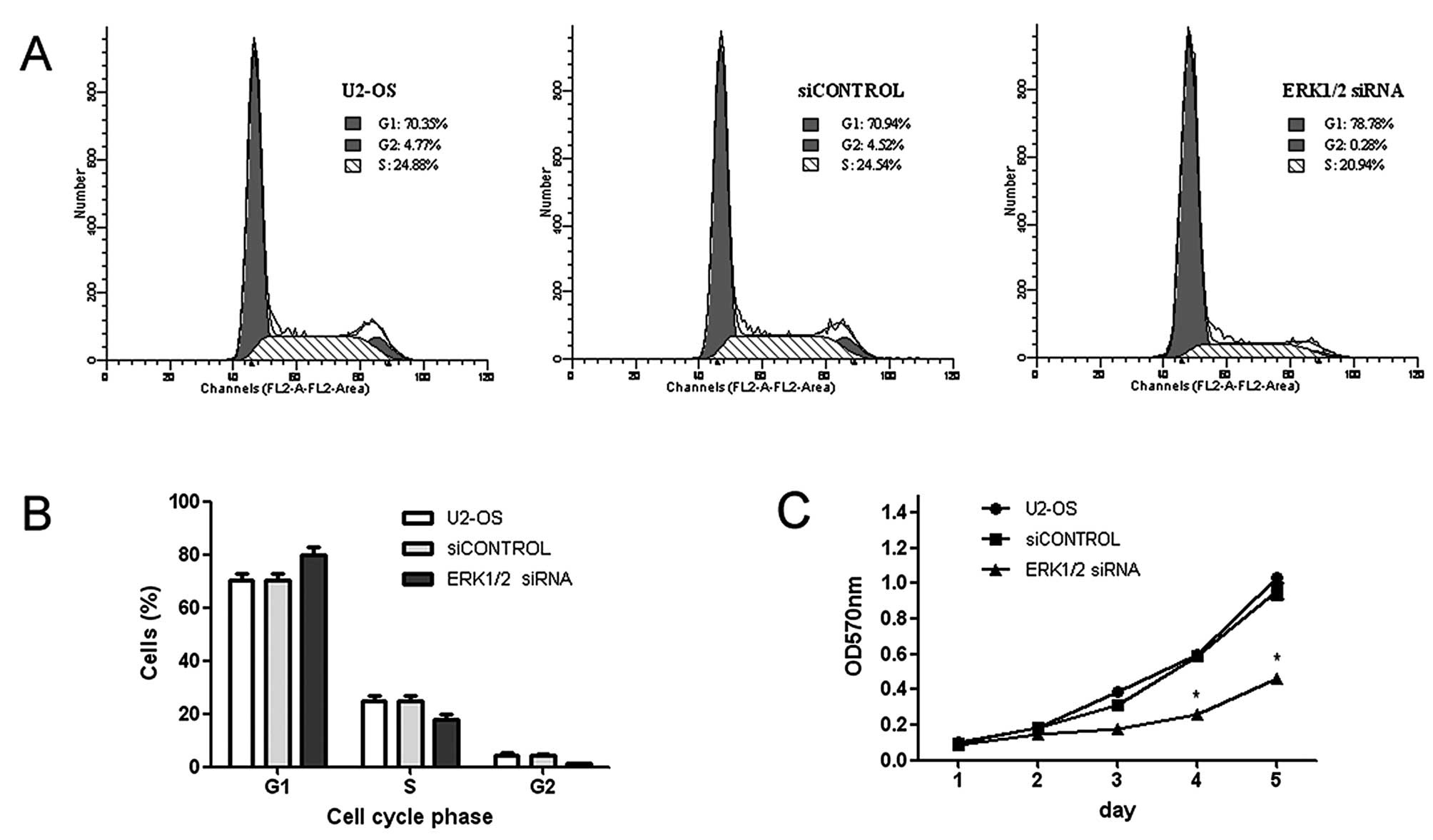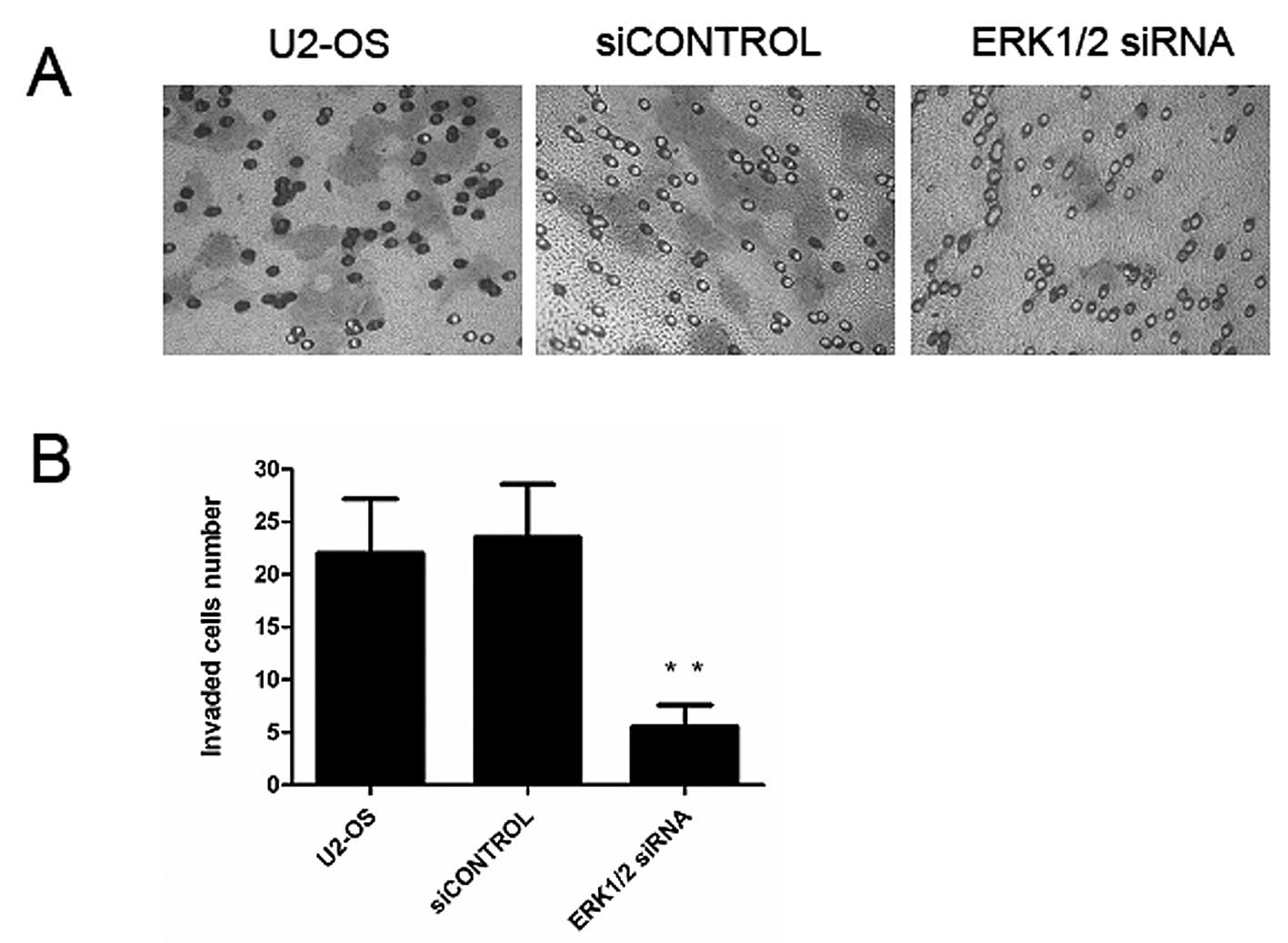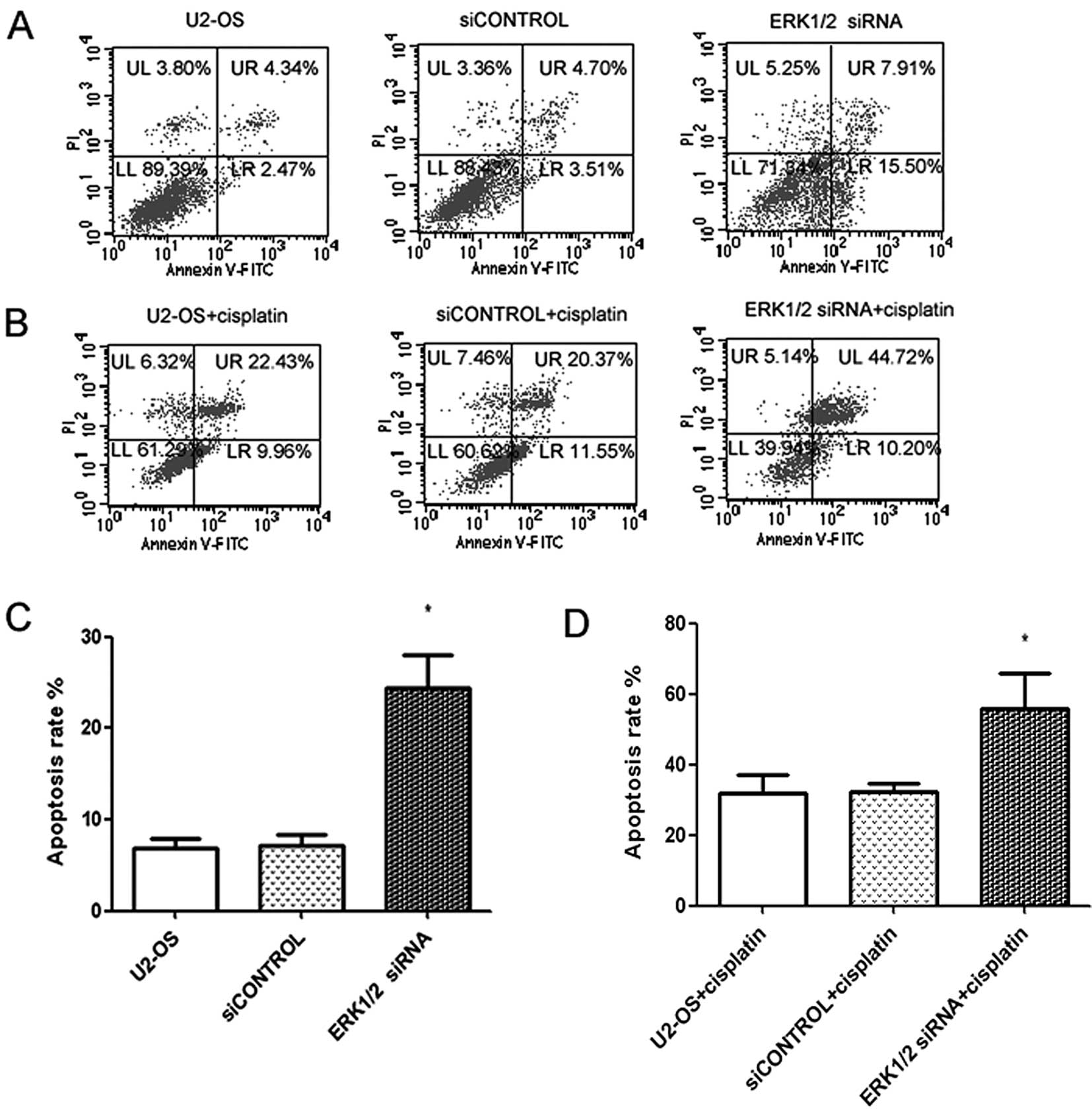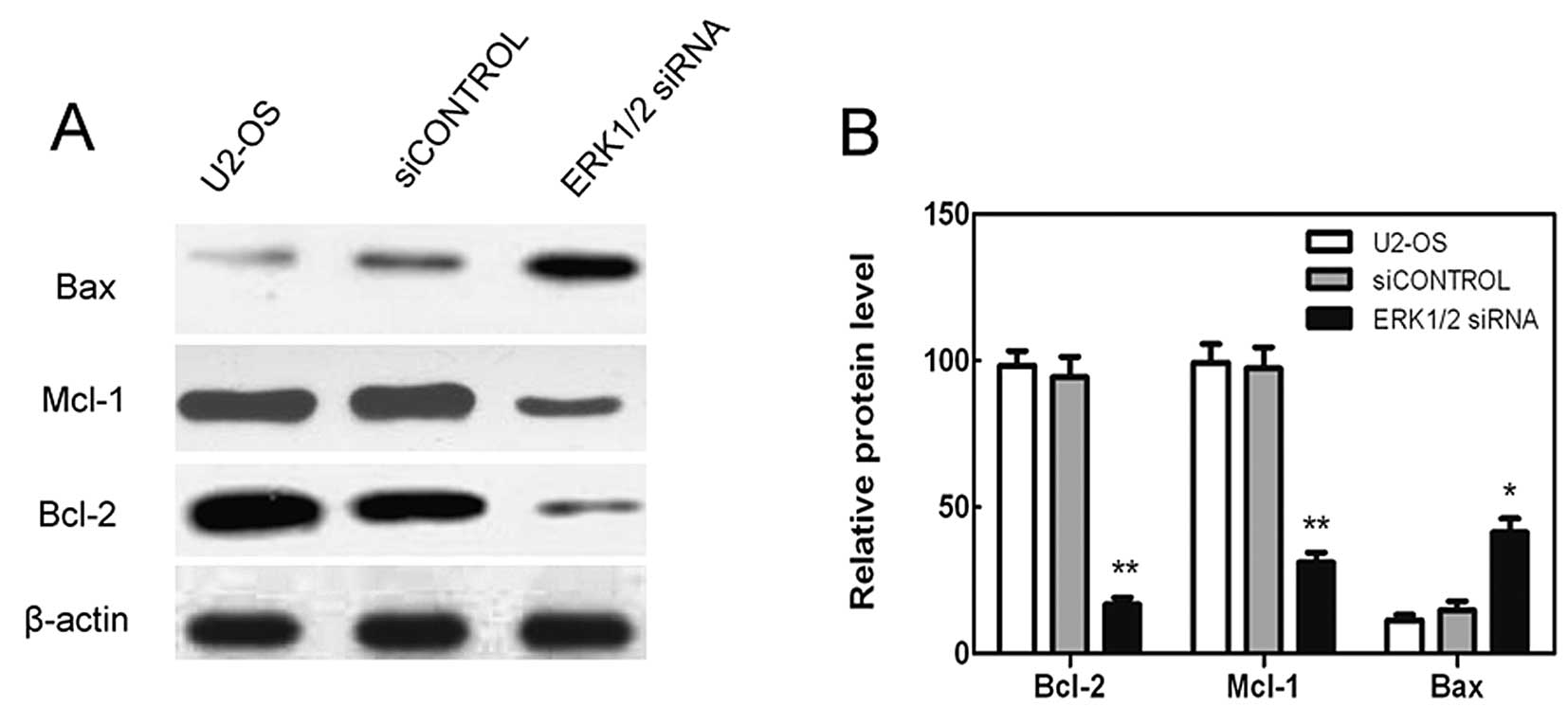RNAi-mediated knockdown of ERK1/2 inhibits cell proliferation and invasion and increases chemosensitivity to cisplatin in human osteosarcoma U2-OS cells in vitro
- Authors:
- Published online on: December 15, 2011 https://doi.org/10.3892/ijo.2011.1303
- Pages: 1291-1297
Abstract
Introduction
Osteosarcoma (OS) remains the most common primary malignant bone cancer affecting children and adolescents (1). Although the combination of modern surgery and systemic chemotherapy has improved OS treatment dramatically, no substantial change in survival has been seen over the past 20 years (2). For this reason, understanding the mechanisms underlying OS as well as identifications of new molecular targets are of great importance.
Mitogen-activated protein kinases (MAPK) are a family of serine/threonine protein kinases widely conserved among eukaryotes and plays essential roles in many cellular programs such as cell proliferation, cell differentiation, cell movement and cell death. The classical MAPK pathway consists of RAS, RAF, MEK and ERK, sequentially relaying proliferative signals generated at the cell surface receptors and through cytoplasmic signaling into the nucleus (3). Under normal cellular conditions, this pathway is stimulated by the binding of mitogens, hormones, or neurotransmitters to receptor tyrosine kinases, which upon dimerization triggers the activation of oncogenic RAS to increase cellular RAS-GTP levels. Activated RAS then triggers the formation of the ‘MAPK complex’ with downstream RAF, MEK1/2, ERK1/2. Once activated, ERK1/2 regulates the expression of several genes involved in cell proliferation, differentiation and survival by phosphorylating nuclear transcription factors such as ETS, ELK-1, MYC or indirectly by targeting intracellular signaling molecules such as p90-RSK. The ERK1/2 also has profound effects on the regulation of apoptosis by the post-translational phosphorylation of apoptotic regulatory molecules including Bad, Bim, Mcl-1, caspase 9 and Bcl-2 (3–5). Constitutive ERK1/2 activation is often due to overexpression or mutation of upstream receptor tyrosine kinases such as EGFR, PDGFR, or VEGFR, increased expression of growth factor ligands, or mutational activation of Ras and its downstream effectors (6).
The involvement of constitutive ERK1/2 activation in the proliferation and tumoral progression has been largely reported in many cancer cells including malignant melanomas (7), human hepatocellular carcinoma (8), esophagogastric cancer (9), breast cancer (10), renal cell carcinomas (11) and leukemia (12). The hyperactivation of ERK1/2 also has been shown to promote resistance to chemotherapy drugs in many cancer cells (4,5,13). Therefore, ERK1/2 could be a good therapeutic target, as agents inhibiting the action of ERK1/2 might prevent tumor cell proliferation, promote apoptosis and reverse resistance to therapy.
Although ERK1/2 was shown to be overexpressed in OS cells and has been implicated as playing important roles in the development of OS (14,15), the exact function of ERK1/2 in OS growth and progression is not fully understood. Inhibition of ERK1/2 has been shown to enhance the chemosensitivity of the cancer cells towards the anticancer drugs (4,5). But the relationship between ERK1/2 expression and response to chemotherapy in human osteosarcoma cells has not been elucidated. Small interfering RNA (siRNA) is a highly specific and efficient tool to silence target genes (16). In the present study, we employed siRNA targeting ERK1/2 to explore the potential of new therapeutic targets in the treatment of OS. Our results suggest that knockdown of ERK1/2 could inhibit OS proliferation and invasion, and could significantly increase the chemosensitivity to cisplatin-induced apoptosis in OS cells. Thus, ERK would be a good molecular target for OS therapy.
Materials and methods
Cell culture and siRNA transfection
Human osteosarcoma cell line (U2-OS) was obtained from the American Type Culture Collection (ATCC, Rockville, MD, USA). Cells were cultured in Dulbecco’s modified Eagle’s medium (Gibco RL, Grand Island, NY, USA) supplemented with 10% fetal bovine serum, penicillin (100 U/ml) and streptomycin (100 μg/ml) in a humidified 5% CO2 atmosphere. The human ERK1 and ERK2 specific siRNA were based on NCBI Reference Sequences (GenBank: ERK1: NM_002746.2 and ERK2: NM_002745.4). ERK1/2 siRNA and scrambled control siRNA (siCONTROL) were purchased from Cell Signaling Technology (Beverly, MA, USA). All of the siRNA transfections were performed using Lipofectamine 2000 (Invitrogen, Carlsbad, CA, USA) in Opti-MEM (Invitrogen) according to the manufacturer’s protocol with a final siRNA concentration of 100 nM. The transfection reagent was removed after 12 h and the cells were harvested after 48 h.
Real-time PCR analysis
Total RNA was isolated from transfected cells using TRIzol reagent (Invitrogen). RNA was first retro-transcribed using TaqMan® Reverse Transcription Kit (Applied Biosystems, Foster City, CA, USA) and then real-time PCR was carried out using and TaqMan SYBR Green Master Mix (Applied Biosystems). β-actin was applied as an internal control. The following primers were used: ERK1: 5′-CGCTACACGC AGTTGCAGTACA-3′ forward and 5′-AAGCGCAGCAGG ATCTGGA-3′ reverse; ERK2: 5′-TGTTCCCAAATGCTG ACTCCAA-3′ forward and 5′-TCGGGTCGTAATACTGC TCCAGATA-3′ reverse; β-actin: 5′-GGCGGCACCACCATG TACCCT-3′ forward and 5′-AGGGGCCGGACTCGTCATA CT-3′ reverse. The comparative Ct method was used to calculatethe relative abundance of mRNA compared with that of β-actin expression (17).
Western blot analysis
U2-OS cells were lysed in boiling buffer (10 mM) containing 1% SDS and boiled for 5 min. After centrifugation at 20,800 × g for 5 min at 4°C, the supernatant was collected and protein concentration was measured using the BCA assay (Pierce, Rockford, IL, USA). A total of 30 μg of protein per sample was resolved by 10% SDS-PAGE, followed by electro-transfer to PVDF membranes (Millipore, Bedford, MA, USA). After transfer, the membranes were blocked with 5% skim milk and probed with specific primary antibodies overnight followed by 1 μg/ml horseradish peroxidase conjugated secondary antibody. Antibodies against p44/42 MAPK (Erk1/2) antibody (1:1000 dilution) and phospho-p44/42 MAPK (Erk1/2) (Thr202/Tyr204) antibody (1:1000 dilution) were from Cell Signaling Technology (Beverly, MA, USA); antibodies for Bax (1:500 dilution), Bcl-2 (1:500 dilution), Mcl-1 (1:500 dilution), β-actin (1:500 dilution) and anti-mouse and anti-rabbit antibodies linked with horseradish peroxidase were from Santa Cruz (Santa Cruz, CA, USA). Western blotting was performed as described previously (18).
MTT assays for cell proliferation
Briefly, 3×103 cells per well were plated in a 96-well plate. After 48 h of incubation, cells were treated with ERK1/2 siRNA, scrambled control siRNA or with medium alone. At various time-points, 3-(4,5-dimethyl-thiazol-2-yl)-2, 5-diphenyltetrazolium bromide (MTT) (Sigma, St. Louis, MO, USA) was added into each well at a final concentration of 5 mg/ml and allowed to incubate at 37°C for 4 h. DMSO (150 μl) was then added to stop the reaction and measured with an ELISA reader (Bio-Rad, Hercules, CA, USA) at a wavelength of 570 nm. Viability of cells was expressed relative to theoretical absorbance (A). Each experiment was performed in triplicate.
Cell cycle analysis by flow cytometer
U2-OS cells (5×105) were seeded into each well of a 6-well culture plate and incubated overnight. Cells were then transfected with the indicated siRNAs. After an additional incubation for 48 h, cells were detached and fixed with 500 μl of 70% ethanol at −20°C for 2 h. Subsequently, the cells were washed twice with PBS then stained with propidium iodide (50 μg/ml propidium iodide and 100 μg/ml RNase A in PBS) at 37°C for 30 min. Cell cycle analysis was performed on a FACScan flow cytometer (Becton-Dickinson, San Jose, CA, USA).
Annexin V-propidium iodide (AnnV/PI) staining apoptosis test
After siRNA transfection and cisplatin (10 μg/ml) (Sigma) treatment, cells in each well were harvested and cell apoptosis was detected by Annexin V-FITC/PI staining method. The experiments were done in triplicate for each sample, and analyses were performed using a FACScan flow cytometer (Becton-Dickinson) in accordance with the manufacturer’s guidelines.
Invasion assay
Cell invasion assay was performed in BioCoat transwell chambers (Corning Costar, Cambridge, MA, USA) with uncoated porous inserts (pore size 8 μm) as previously described (19). Matrigel™ Matrix (BD Biosciences, San Jose, CA, USA) was diluted 1:5 using serum-free DMEM medium and added to the transwell inserts. Cells at 1×104/ml from different groups were spread on the transwell inserts pre-coated with Matrigel in 24-well plates and cultured in serum-free DMEM. Medium containing 10% FBS was added to the lower chamber as a chemoattractant. After 24-h incubation at 37°C in a 5% CO2 incubator, the insert was washed with PBS, and cells on the upper surface of the insert were wiped off using a cotton swab. Cells that migrated to the bottom surface of the insert were fixed with methanol and stained by Giemsa. The number of cells was counted under the microscope from randomly selected five fields (magnification ×400).
Statistical analysis
Results are expressed as means ± standard deviation (SD). Statistical analyses were performed using SPSS statistical software (SPSS Inc., Chicago, IL, USA). The statistical significance of the results was determined using the Student’s t-test. Data were considered significant at P<0.05.
Results
siRNA targeting ERK1/2 knocks down ERK1/2 expression
Since ERK1/2 levels are significantly higher in tumor cells (including osteosarcoma) than that in normal cells, we sought to determine whether the synthetic ERK1/2 siRNA could inhibit the expression of ERK1/2 gene in U2-OS cells. Forty-eight hours after siRNA transfection, ERK1/2 mRNA and protein were measured by quantitative real-time PCR and Western blotting, respectively. As shown in Fig. 1, ERK1/2 siRNA could specifically and efficiently suppress ERK1/2 expression at both mRNA and protein levels compared to cells treated with siCONTROL and the untreated cells.
ERK1/2 knockdown inhibits osteosarcoma cell growth
To determine whether ERK1/2 siRNA had an inhibitory effect on U2-OS cell growth, we first performed determination of cell proliferation with MTT assay. Fig. 2C showed that the growth curves for ERK1/2 knockdown cells were significantly lower than those for control cells for 5 days of incubation. Furthermore, the cell cycle distribution of control and transfected cells was analyzed by flow cytometry. As shown in Fig. 2A, there was a significant increase in the percentage of cells in G1 phase after transfection with ERK1/2 siRNA. In detail, the percentage of cells at G1 phase increased by 7.84% in the U2-OS cells transfected with the ERK1/2 siRNA while the percentage of cells at S phase decreased by 3.60% (Fig. 2A). The cells transfected with the siCONTROL were set as the control group. This result indicated that siRNA arrested the cells in G0 and G1 phases, delayed the progression of cell cycle and inhibited cell proliferation.
Downregulation of ERK1/2 inhibits osteosarcoma cell invasion
Cancer cell migration and invasion play very important roles in cancer metastasis. So, we further studied the effect of ERK1/2 suppression on the invasion in U2-OS cells. The results showed that the migratory ability was significantly reduced through Matrigel coated chamber membranes (P<0.01, Fig. 3) compared with the untreated group, or the siCONTROL group. These results indicate that silencing of ERK1/2 plays an inhibitory effect on the invasion of U2-OS cells.
Inhibition of ERK1/2 increases sensitivity of U2-OS cells to chemotherapy
Upregulation of the ERK1/2 gene has been reported to be closely related to chemotherapy resistance, and inhibition of the ERK1/2 gene has been shown to increase the sensitivity of tumor cells to chemotherapeutic agents (20,21). These exciting data prompted us to investigate the possibility of the combination of cisplatin treatment and ERK1/2 depletion as a clinical strategy for osteosarcoma chemotherapy. The effect of ERK1/2 siRNA and cisplatin on cell apoptosis was examined in U2-OS cell line by flow cytometric analysis. As shown in Fig. 4A and C, cell apoptosis was induced after transfection with ERK1/2 siRNA at 48 h. However, cell apoptosis was further enhanced when cells were treated with 10 μg/ml cisplatin (Fig. 4B and D), suggesting that combining ERK1/2 inhibition with cisplatin increased the incidence of apoptosis.
ERK1/2 knockdown decreases the expression of anti-apoptotic proteins Bcl-2 and Mcl-1 while increases the expression of proapoptotic protein Bax in U2-OS cells
In order to gain a better understanding of the mechanism leading to cell death, the tumor cells were analyzed for the alteration of different kinds of anti-apoptotic and pro-apoptotic Bcl-2 family proteins. While ERK1/2 knockdown caused downregulation of Bcl-2 and Mcl-1, increased levels of Bax were evident (Fig. 5). Levels of Bcl-2, Mcl-1 and Bax did not show a clear change as the cell was transfected with the control siRNA (Fig. 5). Therefore, ERK1/2 knockdown caused the increased cell death by activating pro-apoptotic Bcl-2 members, while inhibiting the anti-apoptotic ones.
Discussion
Osteosarcoma (OS) is the most frequent primary bone sarcoma, accounting for approximately 20% of all primary sarcomas in bone and approximately 5% of pediatric tumors overall (1). OS is characterized by aggressive invasion, early metastasis and resistance to existing chemotherapeutic agents or radiotherapy. Despite advances in surgical and chemotherapeutic strategies, the prognosis of osteosarcoma patients remains unfavorable (22). The failure to improve outcomes with treatment intensification indicates the need for novel and effective antitumor strategies, such as targeted therapy.
Constitutive activation of ERK1/2 has been implicated in a wide variety of processes in the cancer cell during the regulation of cell mortality, apoptosis, angiogenesis, invasion and metastasis, and cell division cycle (4,23). On the basis of the importance of ERK1/2 in tumor progression and survival, ERK1/2 recently has been considered as a molecular target for cancer chemotherapeutics (23–25). Studies with genetic approaches including antisense oligonucleotides and RNA interference (RNAi) have demonstrated that inhibition of ERK1/2 signaling suppresses tumor growth and induces apoptosis in vitro and in vivo (26–28). Moreover, pharmacological agents including gefitinib and sorafenib have also been demonstrated to be potential anticancer drugs due to their inhibitory effects on ERK1/2 signaling (29,30).
Inhibiting specific gene expression by RNAi has become an important method of cancer treatment (31,32). Recently, ERK1/2 signal pathway was shown to be overexpressed in OS cells and has been proposed as a novel marker of poor outcome in OS (14,33,34). To explore whether ERK1/2 could become a potential molecular target for gene therapy of osteosarcoma, we employed RNAi technology to downregulate ERK1/2 expression in a human cell line of osteosarcoma, U2-OS. Comparing with control group, the mRNA and protein expressions were decreased significantly in the cells transfected with the ERK1/2 siRNA. These results indicated that ERK1/2 siRNA could silence the expression of ERK1/2 effectively and specifically in U2-OS cells.
We next examined the consequences of U2-OS cells transfected with ERK1/2 siRNA. The proliferation rate was analyzed by MTT and the cell cycle distribution was tested by flow cytometry, then we found that ERK1/2 knocked down by siRNA suppressed cell proliferation and induced an accumulation in G1 phase concomitant with a decrease in the S phase in U2-OS cells in vitro. The results suggested that the observed growth-inhibitory effect of ERK1/2 siRNA on U2-OS cells could be mediated through modulation of cell cycle progression. Our results are in line with others who showed that inhibition of ERK1/2 signaling induced cell cycle arrest in G0/G1 phase and reduced proliferation in cancer cells (35,36). These results manifested that ERK1/2 plays an important role both in cell proliferation and cell cycle.
It is known that ERK1/2 phosphorylation and the subsequent activation of myosin light chain kinase can modulate focal contact dynamics in motile cells, promote migration and invasion (5,7). We further studied the effect of ERK1/2 suppression on the migration of U2-OS cells by mobility assays. The results showed that the migratory ability was significantly reduced through Matrigel coated chamber membranes compared with the control group. Therefore, there is a strong relationship between ERK1/2 and the invasion or migration ability of human osteosarcoma cells. These results are consistent with other recent reports that showed that inhibition of ERK1/2 signaling could reduce the migration and invasion of tumor cells (37,38).
An important downstream effect of ERK1/2 activation is the ERK1/2-dependent regulation of antiapoptotic Bcl-2 family genes (6). Bcl-2 and its dominant inhibitor Bax are key regulators of cell growth and apoptosis. The anti-apoptotic Bcl-2 proteins protect cells from apoptosis, while Bax accelerates cell death in response to certain apoptotic stimuli. Treatment with ERK1/2 siRNA induced apoptosis (Fig. 4A and C) with corresponding decrease in ERK1/2 activation, accompanied by the reduction of Bcl-2 and Mcl-1 and upregulation of the levels of Bax protein in U2-OS cells (Fig. 5). Such effects may be the important mechanisms of action of ERK1/2 induced apoptosis and suppressed the growth of the U2-OS cells. The displayed results correspond with other recent reports that showed that inhibition of ERK1/2 signaling was accompanied by growth inhibition and induction of apoptosis (39,40). But understanding the detailed molecular mechanisms needs further investigation.
Drug resistance is an important cause of treatment failure and mortality in OS patients. Cisplatin is one of the most commonly used anticancer drugs, but its application has been limited by the presence of cellular resistance (41). Upregulation of ERK1/2 was reported in multidrug resistant cancers cells (20). Numerous reports have shown convincing data that the inhibition of ERK1/2 could sensitize tumor cells to cisplatin-induced cell death (42–44). However, the relationship between ERK1/2 expression and response to chemotherapy in human osteosarcoma cells has not been disclosed. Here, we postulate that inhibition of ERK1/2 expression via RNAi could increase the chemosensitivity to cisplatin. As expected, knockdown of ERK1/2 expression contributed to sensitizing osteosarcoma cells to the anticancer drug cisplatin by increasing apoptosis.
In this report, we have shown that downexpression of ERK1/2 by siRNA inhibited the growth and invasion of U2-OS cells, and found that the knockdown of ERK1/2 made cancer cells more sensitive to cisplatin treatment and that the depletion of ERK1/2 enhanced cisplatin-induced apoptosis. Furthermore, we demonstrated that the knockdown of ERK1/2 regulates the expression level of Bcl-2, Mcl-1 and Bax. All these findings suggest that ERK1/2 may have the wide therapeutic and/or adjuvant application in the treatment of human osteosarcoma.
Acknowledgements
This study was supported by the Scientific and Technological Project of Shandong Province, P.R. China (2007GG30002029).














